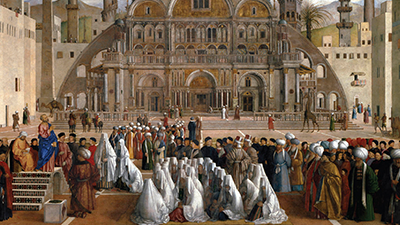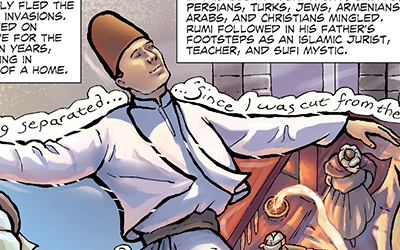Cultural Consequences of Connectivity
Teacher Resources
Driving Question: How did expanding networks of exchange affect cultural amalgamation?
The networks of exchange across Afro-Eurasia facilitated not only the movement of goods, diseases, and people, but also the significant transfer of science, technology, and culture. Long-distance travelers like Mansa Musa played a key role in spreading these ideas, with religions expanding and advancements in fields such as astronomy, medicine, and mathematics reaching new regions. These exchanges contributed to the development of a shared global body of knowledge that transcended borders.
Learning Objectives:
- Explain the intellectual and cultural effects of the various networks of exchange in Afro-Eurasia from c. 1200 to c. 1450.
- Use historical thinking skills and reasoning practices such as sourcing, contextualization, comparison, continuity and change over time (CCOT), and claim testing to evaluate historical events and processes.
Vocab Terms:
- culture
- diffusion
- indigenous
- migration
- pastoral
- syncretism
Opener: Cultural Consequences of Connectivity
To teach this lesson step, refer to page 2 of Lesson 2.5 Teaching Guide.
Check out this one-pager on contextualization for tips on how to teach this important skill.
It can be hard to fully understand a situation if you don’t have the full picture—literally and figuratively. Contextualizing helps you gather all the surrounding facts and details to ensure you’re not missing anything important.
Trade, Technology, and Religion in Afro-Eurasia, 1200–1450
To teach this lesson step, refer to page 3 of Lesson 2.5 Teaching Guide.
Check out this thread for ideas on how to modify the three-step reading tool.
Meeting new people or coming into contact with new things might make you reevaluate the way you think or feel about things. Certainly, that was the case with all the Afro-Eurasian cultural diffusion going on circa 1200-1450!
-
Guiding Questions
-
Before you read
Preview the questions below, and then skim the article. Be sure to look at the section headings and any images.
While you read
Look for answers to these questions:
- Did most people in Afro-Eurasia travel extensively between 1200 and 1450?
- In this same period, what two main Afro-Eurasian regions/cultures made the most significant contributions to technology spreading to other regions?
- What were some of the major technological contributions made by China and the Islamic world in this period?
- What different religious traditions came together in Southeast Asia in this period?
- According to the article, what shape did Islam take in many of its movements and adaptations around the region?
After you read
Respond to the following questions:
- To what extent does this article help you to explain the intellectual and cultural effects of the various networks of exchange in Afro-Eurasia from c. 1200 to 1450?
- This article gives some examples about how ideas, including religions, were adopted in new areas in this period. Based on evidence from the article, why do you think people were willing or even enthusiastic to adopt ideas coming in from other places? What were their motives?
Graphic Biography: Rumi
To teach this lesson step, refer to page 4 of Lesson 2.5 Teaching Guide.
Teachers are talking about the Three Close Reads for Graphic Biographies Tool in this thread on our Community forum.
Poetry has the power to communicate in a way that standard writing sometimes cannot. This is certainly the case with Rumi, who affected many with his poetry.
-
Guiding Questions
-
Before you read
Preview the questions below, and then skim the comic. Be sure to look at the section headings and any images.
While you read
Look for answers to these questions:
- Where did Rumi live as a young man, and what was his home city like?
- How did meeting Shams Al-Dīn transform Rumi?
- Why did the ban on religious icons stir up such a strong response from Byzantine communities?
- What did Rumi teach and write about?
- What is the meaning of Rumi’s poem about a reed, shown around his body in the biography?
- How does the artist’s design reflect the theme of crossing or transcending borders?
After you read
Look for answers to these questions:
- To what extent does this graphic biography explain how belief systems influenced society in the period from c. 1200 to 1450 CE?
- How does this biography of Rumi support, extend, or challenge what you have learned about this period in world history?
- What did you find surprising or significant about Rumi’s life and biography?
Contextualizing: Mansa Musa
To teach this lesson step, refer to page 5 of Lesson 2.5 Teaching Guide.
In this thread, teachers provide tips for contextualizing Mansa Musa’s journey to Mecca.
Imagine being one of the richest people who ever lived! What kind of effect do you think you would have on society? Or history? Build on your contextualization skills as you learn about an individual who both shaped and was shaped by his circumstances: Mansa Musa.
-
Guiding Questions
-
Before you watch
Preview the questions below, and then review the transcript.
While you watch
Look for answers to these questions:
- John Green points out that most sub-Saharan African histories were preserved by oral tradition rather than by being written down. He also says there is a prejudice against oral tradition. What evidence does he use to argue that oral tradition is in fact important?
- Who was Mansa Musa, and why was his hajj (pilgrimage to Mecca) so significant?
- What was Mali like when Mansa Musa ruled it, in terms of both politics and religion?
- What kinds of states were built along the eastern coast of Africa at this time, and how were they linked?
- For a long time, scholars incorrectly believed the Swahili city-states in East Africa must have been founded by Arabs, rather than local Africans. Why did they believe that, according to John Green?
- What kinds of goods were traded through the Swahili city-states?
After you watch
Respond to the following questions:
- To what extent does this video explain how systems of belief and their practices affected African societies in the period from c. 1200 to 1450?
- Why do you think two different kinds of states formed in different African regions (large empires in the interior of West Africa and city-states along the coast of East Africa)?
- How is Mansa Musa’s life evidence of a wider network connecting societies in multiple regions in this period?
Key Ideas
World of Chaco
To teach this lesson step, refer to page 8 of Lesson 2.5 Teaching Guide.
Check out this blog post which highlights the importance of teaching Indigenous histories.
What are the qualities or conditions that would make an area the center of trade for a region? Chaco Canyon in modern-day New Mexico was one such center—but what about it made it so special?
-
Guiding Questions
-
Before you watch
Preview the questions below, and then review the transcript.
While you watch
Look for answers to these questions:
- What sorts of buildings were constructed at Chaco Canyon and who built them?
- What are kivas and what are outliers?
- How many people lived in the Chaco Canyon region? Why did this number change?
- Why is it wrong to think of Chaco as a center?
- Why is it important that some Pueblo peoples today describe themselves as being “of Chaco”?
- According to Brian Vallo, what sort of trade and long-distance connections did the people at Chaco Canyon have?
After you watch
Respond to the following questions:
- In what ways was Chaco Canyon similar to other complex societies you’re learning about? How was it different?
- All three speakers in this video argue that the history and memory of Chaco Canyon remains important to Pueblo communities in the present. Can you think of other histories or historical sites in other parts of the world that have similar importance for people today?
Key Ideas
Closer: Cultural Consequences of Connectivity
Group Problem-Solving: Together or Alone?
Try this: Present students with a historical dilemma. In the fourteenth century, the Guanche people were living in the Canary Islands off the northwest coast of Africa. In 1312, an Italian navigator named Lancelotto Malocello landed on the island.
- Have student role-play as islanders deciding whether to remain isolated or engage with outsiders.
- They develop 10 questions to ask Malocello, then prompt AI for more.
- After refining the list, students compare how AI shaped their thinking.
Behind the design: Students learn that AI can help expand how we ask questions. They deepen their understanding of historical dilemmas and the risks and rewards of global connectivity.
Have you ever traveled far from home? Most likely, you kept in touch by calling, texting, or maybe emailing! What did you talk about? Now imagine traveling in the thirteenth century—what would you write home about?
Pros and Cons of Cultural Connectivity
Was cultural connectivity more positive or negative? Time to assess the consequences of connectivity.







